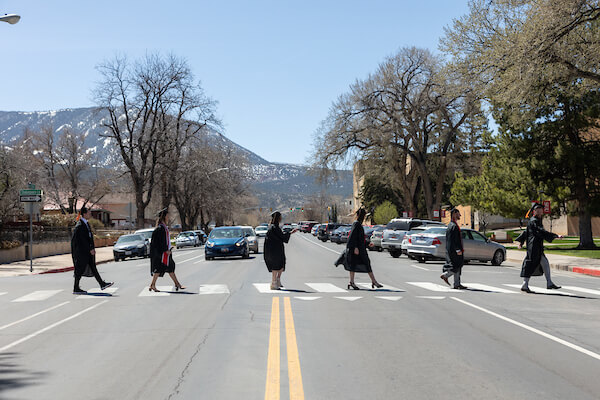Road & Pedestrian Safety Tips

With so many people coming and going from campus every day - whether on foot, pedals, or driving behind the wheel - it's crucial to stay alert and look out for your fellow T-Birds. The SUU University Police and Enterprise Risk Management departments offer these tips to keep you safe as you travel about campus:
Driver Safety Tips:
- Be Alert: Always watch out for pedestrians, especially in high-traffic areas. Always check your blind spots before turning or changing lanes. Attentive driving is crucial with large groups of people and vehicles navigating campus.
- Adjust Speed: Slow down during inclement weather and be extra cautious at night. Adapting your speed to the conditions enhances safety for everyone on the road.
- Yield to Pedestrians: Give pedestrians the right of way, especially at crosswalks. SUU's campus prioritizes pedestrian safety by giving them the right of way.
- Put Your Phone Away: Keep your focus on the road; never text and drive. Texting takes your attention away from driving, increasing the risk of accidents. Distraction-free driving ensures you're fully alert to potential hazards.
- Turn Down the Volume: Don’t wear earbuds or headphones; turn down the volume of any audio device. Eliminating distractions enhances your ability to react to potential hazards on the road.
- Obey Traffic Laws: Respect traffic lights and signals, never running red lights. Maintain a safe following distance behind cars, pedestrians, and bicyclists. Compliance with traffic regulations ensures orderly and safe traffic flow.
- Don't Drive Distracted: Keep your focus on the road. Another reminder to put your phones away. Don’t eat or drink while driving. Keep your windows clear from obstructions. Distraction-free driving ensures you're fully alert and aware of your surroundings.
- Stay Sober: Never drive under the influence of drugs or alcohol. The SUU community prioritizes responsible driving to prevent accidents and ensure the safety of all.
- Be Patient: Allow large and small groups of pedestrians to safely cross; never pass stopped vehicles in crosswalks. Patience behind the wheel promotes a harmonious flow of traffic on campus.
- When the Sun is Low, Go Slow: Be especially cautious when the sun is low in the sky. Glare and strong shadows can impair visibility. Make sure windows are clean and free from frost and snow.
- Use Loading Zones: When picking up or dropping off passengers around campus, use designated loading zones or parking lots. Do not pull off to the side of the road to let passengers out of the vehicle or pick up passengers.
- Use Local Transportation Options: In addition to walking and driving, you can travel by city bus, commercial taxi, or ride-sharing within Cedar City. Review transportation options available to you.
Pedestrian Safety Tips:
- Use Designated Crossings: Cross at marked crosswalks and intersections, obeying signals. Our campus is equipped with well-marked crossings, ensuring safe passage for pedestrians, so become familiar with these crosswalks and parking areas.
- Stay Aware: Be alert for moving vehicles, bicycles, and other campus traffic. With groups of people crossing streets, cars coming in and out of parking lots and utility vehicles navigating campus, staying vigilant is key to avoiding accidents. Make sure you always look both ways before crossing a road, even if the signal is in your favor.
- Put Your Phones Away: Avoid talking on the phone or walking and texting, especially when crossing the street. Store your phone and keep your head up. Distraction-free walking ensures you're fully alert to potential hazards.
- Take Off Headphones: Avoid wearing headphones while walking. Being able to hear your surroundings enhances awareness and safety.
- Stay to the Right: Avoid walking in bike lanes; stick to pedestrian pathways. SUU's pedestrian-friendly design encourages safe walking practices.
- Face Traffic: When sidewalks are unavailable, jog or walk facing oncoming traffic. This practice ensures visibility and allows you to react quickly to approaching vehicles.
- Make Eye Contact: Signal your intention to cross by making eye contact with drivers. Communication between pedestrians and drivers enhances safety at intersections.
- Be Visible: Wear bright colors and stay in well-lit areas, especially at night. Visibility is essential, especially during low-light conditions.
- Stay Clear: Avoid stepping into traffic from behind obstructions. This practice helps prevent unexpected encounters with vehicles.
If you are involved in any kind of accident, especially a pedestrian-motor vehicle accident, please use these resources:
- Do not leave the scene. Immediately call 911 or the SUU Police Department at 435-586-1911, even if it’s a minor accident.
- Contact Student Affairs or Counseling and Psychological Services if you need support or mental health resources.
Remember, every journey on the road involves shared responsibility. By following these safety tips, we can all contribute to a safer campus environment for every T-Bird.

